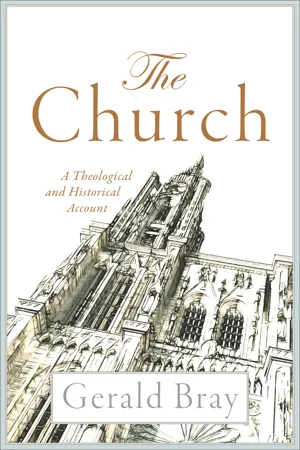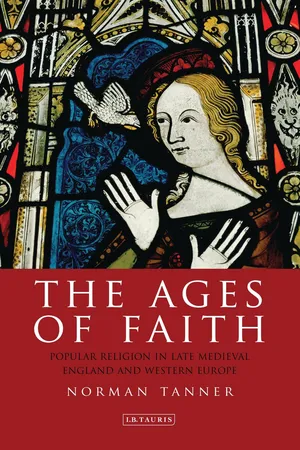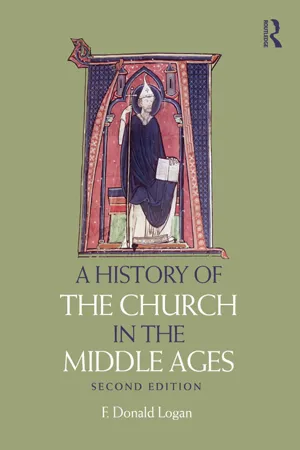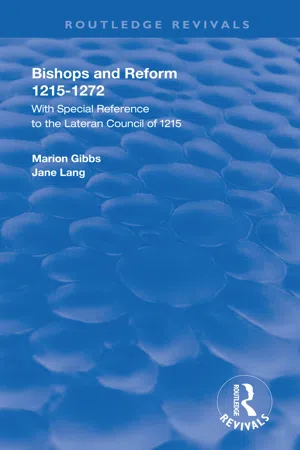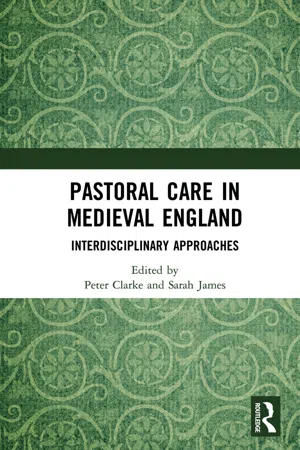History
Fourth Lateran Council
The Fourth Lateran Council was a significant ecumenical council of the Roman Catholic Church held in 1215. It addressed various issues, including the crusades, heresies, and church reform. The council also established doctrinal definitions, such as the belief in transubstantiation, and introduced measures to regulate the clergy and combat corruption within the church.
Written by Perlego with AI-assistance
Related key terms
8 Key excerpts on "Fourth Lateran Council"
- eBook - ePub
The Church
A Theological and Historical Account
- (Author)
- 2016(Publication Date)
- Baker Academic(Publisher)
5 The Crisis of the Imperial Church The Crisis of AuthorityWhen Pope Innocent III (r. 1198–1216) summoned what was to become the Fourth Lateran Council in 1215, he and his church were at the height of their power and influence. The council turned out to be the last of the great reforming synods that had met over the previous century in the Lateran, the papal palace in Rome, in order to establish ground rules for administering the vast international network that the Roman church had become. The First Lateran Council had assembled in 1123, after a gap of some 250 years, and legislated against what it saw as the chief abuses of its time. These were the sale of church offices (known as “simony”),1 the cohabitation of priests with women, and the interference of laypeople in the business of the church. The agenda was clear: the church had to put its house in order and create as much distance as it could between its internal affairs and the people to whom it ministered. The Second Lateran Council in 1139 reinforced the previous one by going into greater detail regarding particular abuses, but it also took note of heretics who denied or perverted the sacraments and called on the secular rulers of Europe to stamp them out.2 The Third Lateran Council was held in 1179 and was mainly concerned with correcting abuses in the election of bishops and other clergy, in addition to the problems that had surfaced earlier but had still not been resolved satisfactorily.It was the Fourth Lateran Council, however, that was to make the most far-reaching changes and have the longest-lasting impact on the church. As we would expect from Innocent III, it launched a broadside attack on heresies, which were now seen to be a major danger to the church. The neo-Manichaean Albigensians (or Cathars) in the south of France were denounced, and a Crusade was subsequently organized to suppress them, which it did with the help of the French king. The mystic prophet Joachim da Fiore (d. 1202), whose writings were to exercise great influence on later generations who were inspired by his predictions of the coming reign of the antichrist, were also condemned.3 Peter Lombard’s Sentences were cited for the first time as the chief authority for the church’s doctrine, and after that his work became the standard textbook for theological students across the Western church. Other matters covered included the regulation of confession to a priest, which was strengthened by the imposition of what is known as “the seal of the confessional,” that is to say, the obligation imposed on the priest not to reveal anything confessed to him, even if it was a crime against the law.4 The council also legislated against clandestine marriages by insisting that public notice should be given on at least three occasions beforehand. This created what is known today as the reading of the “banns,” a practice still found in some Anglican and Presbyterian churches.5 - eBook - ePub
The Ages of Faith
Popular Religion in Late Medieval England and Western Europe
- Norman Tanner(Author)
- 2008(Publication Date)
- I.B. Tauris(Publisher)
HAPTER 3Pastoral Care: The Fourth Lateran Council of 1215The Fourth Lateran Council of 1215 opens a unique window onto pastoral care in the Middle Ages.1 Summoned by Pope Innocent III and meeting in the Lateran basilica in Rome during the month of November 1215, the assembly of several hundred bishops and other prelates from all over western Christendom enacted in its 71 decrees the most impressive and influential legislation of all medieval councils.Regarding the preparation for the council, the balance between papal input and that of other contributors is difficult to weigh precisely. Most of the decrees appear to have been drafted by Pope Innocent and the Roman Curia before the beginning of the council, so the task of the latter was largely to rubber-stamp the prepared legislation. More detailed information about possible amendments introduced by individuals is hard to come by, on account of lack of evidence about the council’s proceedings. On the other hand, the decrees were not invented out of nothing. Several of them are traceable to decrees of earlier councils, and in the letters sent out in April 1213 to announce the forthcoming council, bishops were invited to suggest topics for the council. In the next two and a half years, moreover, many local councils were held in preparation, at the Pope’s express wish, and it seems likely that these local councils had some influence upon the decrees that were drafted for Lateran IV. In short, while the principal impetus for the decrees came from the Pope and the Roman Curia, they certainly reflect a wider constituency within the Church. - eBook - ePub
- F Donald Logan(Author)
- 2012(Publication Date)
- Routledge(Publisher)
The 70 canons (or decrees), approved by the Fourth Lateran Council, were not debated in council but were presented by the pope. Not a word was changed, not a canon challenged, not an issue debated: the decrees of the council were the work of the pope and his curia. Apart from the first two decrees, which dealt with dogmatic matters, the decrees of the council concerned the practical life of the church. These decrees were to affect the way Christians lived their Christian lives for centuries to come. The most enduring and penetrating actions of the Fourth Lateran Council had nothing to do with crusades or dogmatic niceties but with the pastoral concerns of the church.A summary of the most significant decrees can only serve to suggest the pastoral dimensions of the council’s work. Central to any attempt to elevate the quality of the Christian life as lived by individual Christians in the hamlets, villages and towns of western Europe was the quality of the clergy charged with the care of souls, which one decree called ‘the art of arts’. It is ‘better to have a few good priests (paucos bonos ) than many bad priests (multos malos )’. Bishops either personally or through others should instruct candidates for the priesthood as to how they should perform the sacred rites and sacraments. But more, extending an enactment of the Third Lateran Council (1179), it was decreed that each cathedral should have a master of grammar who will instruct the clergy and poor scholars gratis, and in metropolitan churches there should also be a master of theology, who will teach priests and others ‘in the sacred page’ and who will especially instruct them in those things which pertain to theMap 13 Representatives at the Fourth Lateran Council (1215)care of souls. Not quite a modern seminary, itself a creature of the sixteenth century, yet the arrangements provided for the training of the clergy in something more than the mere performance of rituals. More than Mass priests, they were expected to be pastors of souls. The council defined their behaviour in explicit terms: - eBook - ePub
The Council of Bourges, 1225
A Documentary History
- Richard Kay(Author)
- 2019(Publication Date)
- Routledge(Publisher)
SECTION FIVEMONASTIC PROVINCIAL CHAPTERS
Document 45INNOCENT III ESTABLISHESMONASTIC CHAPTERS-GENERAL AND VISITORSFourth Lateran Council, 1215Innocent III crowned his energetic years of administration with the greatest of the reforming councils of the medieval Latin Church. 1 The public sessions of the council, held in the Lateran basilica during November 1215, did not deliberate over the reform of the Church, however.2 The seventy canons, for which the Fourth Lateran Council is chiefly remembered, were prepared secretly, recited in public session, and approved as read.3 How they were prepared remains something of a mystery.As was common in medieval conciliar legislation, the Lateran statutes were cast in the form of authoritative prescriptions made by the council’s head and approved by its members. 4 The enacting clause leaves no doubt that the voice of authority is that of Innocent alone, speaking with the plural of majesty: “sicut olim aperte distinximus et nunc sacri approbation concilii confirmamus …” (c. 8). Thus it is not surprising that contemporary copies of the canons frequently bear a title in which the Lateran legislation is credited to Innocent alone. 5 Certainly the pope was ultimately responsible for the decrees he ordained in the council; doubtless, too, they were drafted by his curia; but the council also had its role to play, albeit a supporting one.Assembled in public session, the council expressed its collective approval of the proposed legislation, as such phrases in the canons as “sacro approbante concilio” (c. 47) testify. This, however, was a solemn, ceremonial formality which invited neither debate nor dissent. More important but less known are the legislative procedures by which the statutes were formulated. That they were the product of the council and not merely imposed upon it appears from the rubricella prefixed to the Lateran decrees in Innocent’s own register: “Sequuntur multe ordinationes per diversa capitula facte et ordinate in dicto concilio … ”6 No doubt the pope took counsel in some way with the assembled prelates, although the mechanics of the process are now obscure. In the summons to Lateran IV, the bishops were instructed to ascertain what reforms were needed and to bring their recommendations in writing to the council. 7 Innocent, too, had his proposals on which the prelates were consulted, for in at least one instance an unfavorable response caused him to abandon a reform he had desired. 8 - eBook - ePub
- Marion E. Gibbs(Author)
- 2019(Publication Date)
- Routledge(Publisher)
A study of the promulgation and practical application in. England in the reign of Henry III of such a code of canons as those of the Lateran Council should therefore have a threefold object in view: to reveal the workings of ecclesiastical administration in England at this time; to throw light on the attitude of the Church in England in the thirteenth century towards canon law; and to estimate the degree of fervour and enthusiasm existing in the Church at this time. How were the decrees of a Great Council in the Middle Ages brought before the notice of and obeyed by the least of the servants of the Church, and in what way did the body of English clergy and religious regard such general enactments of the Pope?The task of tracing the influence of the Lateran Council on English provincial and diocesan administration during the years which followed the holding of the Council is complicated by the impossibility of isolating its decrees from the mass of earlier, and later, ecclesiastical legislation. In several clauses of the Lateran Decrees of 1215 reference is made by name to the third Council of the Lateran which had been held in 1179. The enactments of this earlier Council are repeated and expanded. In such cases the origin of certain of the Lateran canons is apparent, but the subtle detection of the multitude of unacknowledged debts to the great body of Canon Law which was widely studied by the canonists of the day in schools and universities as a result of the publication of Gratian’s Decretum in the middle of the previous century, would demand an intricate and specialized study. Nor has it been attempted. The object of these chapters is to discover, as far as possible, to what extent reforms which were mentioned in the Lateran Council of 1215 were carried out.Again, some fifteen years after the holding of the Council, its canons were incorporated in the Decretals of Gregory IX and themselves became an intrinsic part of the Corpus Iuris Canonici. The authority of the Decretals - eBook - ePub
The Decrees of the Fifth Lateran Council (1512–17)
Their Legitimacy, Origins, Contents, and Implementation
- Nelson H. Minnich(Author)
- 2018(Publication Date)
- Routledge(Publisher)
120 .The actions of the prelates which Pio saw as threatening and disruptive of the council probably had little to do with the unfinished business of the council, but with the bishops’ earlier demands for a rescission of the exemption of the mendicant friars and for the establishment of an episcopal college in the Roman Curia to advance their interests. They had threatened to vote down other measures and boycott the sessions if their demands were not met. Because of the adamant opposition of the College of Cardinals to the establishment of a rival college of bishops, Leo was forced to impose a perpetual silence on the proposal121 . Only with great difficulty could he get the bishops to agree to merely a modest reduction in the friars’ privileges. The bishops were also calling for a sweeping reform of the various religious orders to be mandated through the council. The generals of the orders tried to head this off by handling the reform themselves in their general chapters122 . Both Christian rulers and the bishops looked to the council to find a solution to the endless and bitter quarrels among the Friars Minor which previous popes had failed to end. Leo X established a commission of four cardinals (Pucci, Carvajal, Grimani, and Accolti) to study the matter, but its recommendations were not yet available123 .But it was not only prelates who could be the source of disturbances in the council. The ambassadors of rulers, Roman officials and barons, and knights all quarreled over places of honor. The master of ceremonies, in his capacity as the council’s official assigner of seats, tried to impose order. Popes Julius II and Leo X also got involved in the controversies. A ruling by the council could have carried great weight, but there is no record of discussions on this issue in the conciliar deputation on peace124 - eBook - ePub
- Chris Wickham(Author)
- 2016(Publication Date)
- Yale University Press(Publisher)
CHAPTER EIGHT The ambiguities of political reconstruction, 1150–1300When in 1093 King William II of England appointed a new archbishop of Canterbury, Anselm of Bec, he invested him as archbishop with the staff of office, as kings had traditionally done. Anselm soon fell out with William and left the country, arriving in Rome in 1098. Here, however, he discovered that, as we saw earlier, popes had been condemning lay investiture since 1078; so, when he returned to England after William’s death in 1100, he duly informed the new king Henry I that such rituals were invalid. This caused renewed trouble, and peace was made between king and archbishop only in 1107. Anselm was not much given to compromise – hence the trouble – but he was no provincial: he was Italian, he had been abbot of a major Norman monastery, and he was an innovative and respected theologian. That someone as connected as Anselm could have been unaware of one of the major elements of the conflict between popes and emperor tells us something about the lack of density in political communication in the years around 1100.1Contrast the Fourth Lateran Council, held in Rome a century later, in November 1215. This, the largest of medieval church councils, was called by Pope Innocent III in April 1213, and was attended by a huge number of bishops and abbots, over twelve hundred senior clerics from all Europe and even the east. The canons (decrees) of the council covered every angle of church practice as it had by then developed, including elections, the running of church courts, excommunication, judicial ordeal (the council prohibited it), heresy, attitudes to Jews, crusading, and – not least – the development of pastoral care and preaching. Subsequently, they were made available across the whole of Latin Europe, systematically, through the dissemination of the text of the council, and the expectation (partly realised) that bishops would instruct their own parish clergy about it. If these decrees did not result in instant ‘reform’ in most places, as historians point out, that is hardly surprising, although in the longer term many of them did have an effect. Nor were they wholly new, although they were newly ambitious in their aim for uniformity. But more important is that they became a new basis for current practice everywhere.2 - eBook - ePub
Pastoral Care in Medieval England
Interdisciplinary Approaches
- Peter Clarke, Sarah James(Authors)
- 2019(Publication Date)
- Routledge(Publisher)
Enforcing religious conformity in late medieval England Lateran IV canon 21 and the church courtsPeter D. ClarkeOne of the most famous decrees of the Fourth Lateran Council is its twenty-first canon. H. C. Lea called it ‘the most important legislative act in the history of the Church’.1 The canon made it the duty of all adult Catholics to confess all their sins at least once a year to their own priest, to perform as far as possible any penance consequently enjoined on them, and to receive communion at least at Easter on pain of exclusion from church and denial of Christian burial. Canon 21 also obliged priests not to reveal what they heard in confession, otherwise they should suffer deposition from office and enclosure in a strict monastery to do perpetual penance.2 Lea considered this canon so important because in his view regular confession did not exist in the Western Church until 1215 when canon 21 required this. Subsequent historians have disputed this view; Alexander Murray has argued that confession was already becoming more frequent in the twelfth century, and Sarah Hamilton claims that it was widely practiced as early as the tenth century even at the lower levels of society.3 The emerging scholarly consensus is that canon 21 built on existing religious practices and the teachings of twelfth-century theologians. Historians still disagree about how frequent confession was before 1215 but debate much less how common confession or mass-attendance were after 1215, for they generally suppose that canon 21 largely succeeded in making them obligatory, at least on an annual basis as the canon required.4Local ecclesiastical authorities certainly recognised the canon’s importance in defining the minimal religious duties of Catholics.5 In English synodal and episcopal legislation immediately following 1215 the provisions of canon 21 were those most often repeated of all the Lateran IV decrees. Similarly, in Flanders by the fourteenth-century diocesan statutes instructed priests to remind parishioners of their annual duty to confess before receiving communion at Easter. Many studies of late medieval Christianity suggest that these local attempts to enforce canon 21 were effective, even encouraging more frequent religious observance than the canon stipulated. Eamon Duffy has even found evidence of daily mass-attendance among the English nobility by the fifteenth century.6 Thomas Tentler and John Bossy have similarly observed a growing frequency in confession by the late Middle Ages; Tentler cites as evidence the widespread diffusion of confessional handbooks aimed at the laity in this period (not to mention the proliferation of pastoral manuals for confessors).7
Learn about this page
Index pages curate the most relevant extracts from our library of academic textbooks. They’ve been created using an in-house natural language model (NLM), each adding context and meaning to key research topics.
